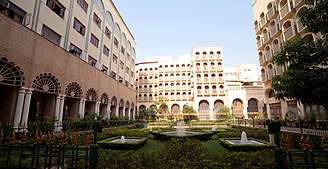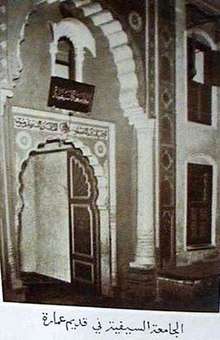Aljamea-tus-Saifiyah
Aljamea-tus-Saifiyah (Arabic: الجامِعةُ السّـيفِيّة, lit. 'The Saifiyah University'; Lisan al-Dawat: الجامعۃ السـیفیۃ; Urdu: جامعۃ سـیفیۃ, romanized: Jamea Saifiyah) is an Arabic academy dedicated to Islamic learning based in India, Pakistan, and Kenya. Established in Surat as Dars-e-Saifee c. 1814 by Abdeali Saifuddin, it was after extensive renovation (c. 1950s) and expansion (c. 1980s and c. 2010s) carried out by Taher Saifuddin and Mohammed Burhanuddin, the University gained prominence.[4][5] Today, as holder of the office of Dāʿī al-Mutlaq, Mufaddal Saifuddin is the sole benefactor of the institute.[6][7]
الجامعۃ السـیفیۃ | |
 Surat Campus | |
Former names | Dars-e-Saifee |
|---|---|
| Type | Private Religious Theological University |
| Established | 1814 |
| Chancellor | Dr. Mohammed Burhanuddin |
| Vice-Chancellor | Dr. Mufaddal Saifuddin |
| Rector |
|
| Students | 2500[1] |
| Location | |
| Campus |
|
| Affiliations | |
| Website |
|
History
It was founded as a theological University for Dawoodi Bohras in 1814 AD (1224AH) by the 43rd Dai Syedna Abdeali Saifuddin who named it Dars-e-Saifee (Urdu: درسِ سيفي, lit. 'Class of Saifee').

The Dawoodi Bohra's 51st Dai, Syedna Taher Saifuddin introduced secular and scientific subjects in the 1960s and gave it the present name of Aljamea-tus-Saifiyah. Its doors were later opened for Bohra girls. The academy, since then, has had separate hostel facilities for boys and girls.
The 52nd Da'i Syedna Mohammed Burhanuddin oversaw a complete rebuilding and expansion of the campus buildings.[8]
In 2011, during centennial celebrations, Syedna Mohammed Burhanuddin established Aljamea-tus-Saifiyah in Nairobi, Kenya. The construction of this 14-acre campus commenced in 2013, and was completed by Mufaddal Saifuddin and inaugurated by President Uhuru Kenyatta on 20 April 2017.[9][10][11]
Curriculum
Its educational focus is the Quran, Islamic sciences, Arabic language, and literature.[12] Students are sent around the world for religious duties during the Ashara (Moharram) and Ramadan.
An eleven-year course of study is divided into three phases. The first phase is four years and involves 55 courses. The second phase is five years, subdivided into three years with 75 courses and two years with 90 subjects. The final two-year phase focuses on specialization and advanced studies in Islamic and Arabic science. Degrees are awarded at successive stages.[2]
At the end of the eleven-year course the students graduate with the degree of Al Faqih Al Jayyid.[2] As per tradition, these graduates invite the Da'i al-Mutlaq for a ziyafat (lit. 'banquet').[13] Per another tradition, they are sent to hajj and other pilgrimages.
The final degree is considered equivalent to the Masters of Arts[2] from Aligarh Muslim University and recognized by Al Azhar and Cairo University. Students who complete the STD V phase are considered to have completed secondary education and qualify to test for an International Baccalaureate.[2] It is recognized by Oxford University and others.
Campus
The principal university campus is situated in Surat (India) with three sister campuses in Karachi (Pakistan), Nairobi (Kenya) and Marol (India.)
The late Syedna Mohammed Burhanuddin along with renovating the Surat campus to a state-of-the-art institute, further expanded and dedicated the institute's outreach to these three campuses. The aesthetics of these campuses complement the purpose of their existence; i.e. to provide an inspiring and highly conducive environment for learning and nurturing.[14]
The separate teaching block houses classrooms and administrative offices, a large hall known as the 'Ewaan' where annual exams are primarily held (amongst other events that involve the entire student and teaching faculties). A small masjid, Al-Masjid al-Fatemi, sits between the garden and the ewaan.
A minaret and a library that houses more than 150,000 books and subscribes to more than 100 periodicals monthly is present.[15]
The campus is adjacent to the 'Devdi Mubarak' where previously the Da'is had their residences. Residential dwellings for the Syedna remain. At the end of this Devdi is the Mahad al-Zahra Quran-teaching institute for students to memorize and pursue Quran studies.
Rectors (Umarāʿ al-Jamea)
Following the death of the rector Amīr al-Jamea Shahzada Yusuf Najmuddin in 1987 (1407 Hijri), Syedna Mohammed Burhanuddin appointed four rectors of Al Jamea tus Saifiyah; his two brothers Shahzada Qasim Hakimuddin, Shahzada Abbas Fakhurdddin, and his two sons Shahzada Qaidjoher Ezzuddin and then Shahzada Mufaddal Saifuddin.[16] Syedna Mohammed Burhanuddin instructed the newly appointed rectors that in the event that there was a difference of opinion amongst them, then Syedna Mufaddal Saifuddin's opinion should take precedence.[17]
Following the death of Syedna Mohammed Burhanuddin, on 16 Rabi Ul Awwal 1435 Hijri (corresponding to 17 January 2014), Syedna Mufaddal Saifuddin appointed his son, Ja'far us Sadiq Imaduddin as the fourth rector of Aljamea-tus-Saifiyah.[18]
After the death of Shehzada Abbas Fakhruddin (14 February 2018) [19] and Shehzada Qasim Hakimuddin (5 April 2018), on 5 April 2018, in Surat, Syedna Mufaddal Saifuddin appointed Shehzada Aliasghar Kalimuddin and Shehzada Malikul Ashtar Shujauddin.
References
- "Current Student Count - Aljamea-tus-Saifiyah". jameasaifiyah.edu. Archived from the original on 11 Jun 2020. Retrieved 11 Jun 2020.
- "The Three Stages". jameasaifiyah.edu. Archived from the original on 11 Jun 2020. Retrieved 11 Jun 2020.
- "People: Syedna Mohammed Burhanuddin" (PDF). 27 (326). Bangalore: Islamic Voice. Feb 2014. p. 17. Archived from the original (PDF) on 18 June 2020 – via islamicvoice.com.
Dr. Burhanuddin greatly modernized the community and its institutions. Under his stewardship the Bohra religious school Jameatus Saifiya at Surat introduced the modern curriculum together with religious curriculum and opted for International Baccalaureate program under IBO.
- "A brief history of Aljamea-tus-Saifiyah". jameasaifiyah.edu. Archived from the original on 11 Jun 2020. Retrieved 11 Jun 2020.
- Mustafa, Shabbir Hussain (2011). "In Defense of the Community: Syedna Taher Saifuddin and Reassertion of Authority". Between Community and Securalism: The Dawoodi Bohras and Agendas of ‘Reform’ in India, c. 1915-1985 (Thesis). National University of Singapore. pp. 60–83. Archived from the original on 13 Jun 2020.
- "Realisation of Aljamea-tus-Saifiyah". jameasaifiyah.ed u. Archived from the original on 23 June 2020. Retrieved 23 June 2020.
- "Timeline of Key Events - Aljamea-tus-Saifiyah". jameasaifiyah.edu. Archived from the original on 11 Jun 2020. Retrieved 11 Jun 2020.
- ; Ismailism and Islam in Modern South Asia, By Soumen Mukherjee; p.180
- "The Dawoodi Bohras - President Kenyatta inaugurates new Aljamea campus in Nairobi". thedawoodibohras.com. Archived from the original on 2017-04-22. Retrieved 2017-04-21.
- "The Dawoodi Bohras - Syedna arrives in Nairobi for Jamea campus opening and annual exam". thedawoodibohras.com. Archived from the original on 2017-04-22. Retrieved 2017-04-21.
- "The Dawoodi Bohras - Arabic academy of Dawoodi Bohra community inaugurated in Nairobi". thedawoodibohras.com. Archived from the original on 2017-04-22. Retrieved 2017-04-21.
- "The Dawoodi Bohras - Education". www.thedawoodibohras.com. Archived from the original on 2016-08-19. Retrieved 2016-07-27.
- Blank, Jonah (2001). "Qasr-e Ali: The Royals". Mullahs on the Mainframe: Islam and Modernity Among the Daudi Bohras. University of Chicago Press. p. 148. ISBN 9780226056760 – via books.google.com.
- A Golden Era. Mumbai: Department of Statistics and Information, Dawat-e-Hadiyah. 2016. p. 18.
- Times of India
- "Aljamea-tus-Saifiyah | Official Website » 1407/1987". jameasaifiyah.edu. Archived from the original on 2016-11-14. Retrieved 2016-11-13.
- His Holiness, Syedna Aali Qadr Mufaddal Saifuddin Saheb (1436H). رسالة النعي المسماة - حكمة الغيبة القدسانية الابدية. His Holiness Syedna Aali Qadr Mufaddal Saifuddin Saheb, Badri Mahal, Mumbai, India.
- His Holiness, Syedna Aali Qadr Mufaddal Saifuddin Saheb (1437H). شكر نعم اصحاب البركات. His Holiness Syedna Aali Qadr Mufaddal Saifuddin Saheb, Badri Mahal, Mumbai, India. p. 1269.
- "Obituary: Shahzada Abbas bhaisaheb Fakhruddin". The Dawoodi Bohras. Archived from the original on 2018-04-12. Retrieved 2018-04-12.
External links
- Official website
- Al Jamea tus Saifiyah Url accessed on Nov 27, 2006
- Al Mawaid
- Al Jamea-tus-Saifiyah, Karachi - Arabic Academy
- The Oxford encyclopedia of the Modern Islamic World